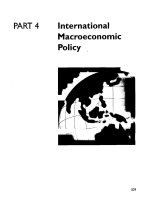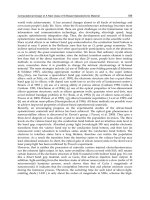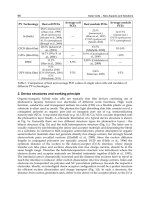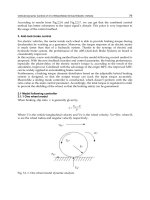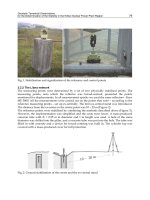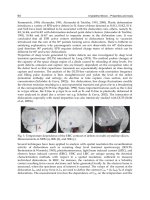Theory of Brain Function quantum mechanics and superstrings - part 4 ppt
Bạn đang xem bản rút gọn của tài liệu. Xem và tải ngay bản đầy đủ của tài liệu tại đây (153.6 KB, 10 trang )
27
the quantum system, and it is only when one feels compelled to “measure”/“observe”
the system, that the probabilistic element of QM emerges. One, of course, tacitly
assumes the existence of a fixed, smooth spacetime background that does not “dis-
turb” the system, acting simply as the arena in which things are happening, and thus
leaving the system “ closed”. The characteristics of such “closed” systems include, of
course, conservation of energy and no definite arrow of time or no flow of time, which
is reflected in the forms of (9) , (18), which are invariant under t → −t! When we
decide to “open” the system we basically perform a “measurement”, i.e., we force the
system to “decide” what it wants to be, by choosing a very specific state, out of many
coexisting possible ones, i.e., we are talking about the “collapse” of the wavefunction.
That’s in a nutshell the Copenhagen interpretation of QM, leaving too much to be
desired, and too much on the “eye” of the “observer”! We need to do better. In the
density matrix mechanics, as represented by (23), and as emerged, in one interpreta-
tion from string theory, one has a stochastic, indeterministic evolution of the quantum
system, ab initio, due to the unavo idable existence of spacetime foam. The uncontrol-
lable, universal quantum fluctuations of the spacetime metric at very short distances
(O(ℓ
P l
)), containing creation and annihilation of virtual Planckian-size BH, agitate
through the global or W
2
-world states, our low-energy quantum system, rendering
it dynamically a nd spontaneously “open”. This is an objective, universal mechanism,
independent of any “observer”, that is always “up and working”, thus erodi ng the
quantum coherence and eventually leading to a dynamical, spontaneous collapse. It
should be clear that the natural “opening” of our quantum system is due to our in-
ability to take into account all the detailed effects of the global states, because of
their delocalized nature, and thus we do truncate them, arriving at the Procrustean
Principle, a new universal princ iple [6] that goes beyond the standard uncertainty
principle (8). Furthermore, since this new dynamical mechanism of the “collapse” of
the wavefunction, as emerged in the EMN approach [51, 5 , 6], is an objective sponta-
neous, time-ordered, and thus an orchestrated one, I propose here to call it synchordic
colla pse.
2
Schematically, one can represent this new mechanism of the “collapse” of
the wavefunction, by using (22), as follows
synchordic
W ⊃ W
1
⊗ W
2
→ cause −→ W
1
||| ||| ||| colla pse
Physical World Attainable Global
(including all local Physical World States
and global states) (including all local, World
low-energy states)
(27)
which makes it apparent that the global or W
2
-world states are t he agents of the
synchrodic collapse, as being the raison d’etre of stochasticity in quantum dynamics.
Also, notice the similarity between (2) and (27), rather remarkable and very sugges-
2
chord=string in greek; synchordia something like symphonia.
28
tive! The most amazing and astonishing thing is that, despite the well-known fact
that usually open, dissipative systems defy quantization and energy conservation,
our naturally “open” system, as represented by (23) a nd as explicitly indicated in
(24), (25), and (26), is different [53, 54]. It is susceptible to quantization, it con-
serves energy in the mean, and monotonically increases its entropy, leading to loss
of information, quantitatively expressed as quantum decoherence, and thus supple-
menting us with a very natura l , universal, objective microscopic arrow of time! In
the EMN approach [51, 5, 6], time is a statistical measure of the interactions (quan -
tum gravitational friction) between the local, low-energy world W
1
and the global or
W
2
-world states, in the presen ce of singular spacetime backgrounds (spacetime foam).
The strong emerging correlation between loss of information, quantum decoherence
leading to wavefunction collapse and the dynamical appearance of flowing time, I
believe is unprecedented in physics.
Clearly, the role of the magic extra term proportional to β
j
in (23), is mul-
tifunctional, as exemplified by making use of the dissipation-fluctuation theorem of
statistical mechanics [14]. It can be viewed as a dissi pative term that destroys quan-
tum coherence, by damping the off-diagonal elements and also it can be seen as a
noise term able to drive the system away from its equilibrium position and, after
some time, bring it back to the same position or bring it to some other equilibrium
position. In o t her words, we may interpret (23) as a renormalization group equation
(RGE), as discussed in section 2, describing the evolution of the system between dif-
ferent phases, each corresponding to one of the infin i te spontaneously broken W
1+∞
symmetries. Clearly, at an equilibrium position, or at a critical point, all β
j
do van-
ish, thus recovering naturally (9) fro m (23), or equivalently recovering standard QFT
as applied to particle physics for the past 70 years. In principle, in fixed, smooth
spacetime backgrounds, hopefully corresponding to critical points in our new stringy
language, there is a decoupling of t he global states from the local, low-energy states in
(22), i.e., all c
g
’s do vanish, and thus implying vanishing β
j
in (23). Before though, we
are carried away from the highly promising stringy big quantum picture that emerges
here, it should pay to have a closer loo k at some numerical details, if not for any other
reason, just as a reality ch eck! Indeed, one can work out, using (23), the time that it
takes for quantum decoherence, or equivalently the quantum coherence lifetime τ
c
, as
defined by the off-diagonal elements damping factor [43]: exp[−Nt(m
6
/M
3
)(∆X)
2
],
for a system of N constituents of mass m, assuming that its center of mass gets finally
pinned down within ∆X, and is given by
τ
c
=
M
3
Nm
6
(∆X)
2
(28)
where M stands for M
SU
≈ (1/10)M
P l
≈ 10
18
GeV, the characteristic string scale
[55]. What about the value of m? The most natural value for it would be m ≈
m
nucleon
≈ 1 GeV for the following reason. Our a t tainable low-energy world, as far as
we know is made up of electrons, protons, and neutrons: that is what constitute us,
i.e., our cells, our proteins, our DNA, etc, and also that is what everything else we
29
use, i.e., the “apparatus”, is made o f. Of course, protons and neutrons are mainly
made of up (u) and down (d) constituent quarks, but fo r my arguments they are of
comparable mass and thus would give the same results. Now, since the bulk of matter
is due to nucleons, and not to electrons (m
nucl
≈ 1836m
e
), the shortest coherence
lifetimes that we are interested in would be provided by m ≈ m
nucl
. Furthermore,
independent of the complicated structure that you may consider, e.g., a complicated
protein polymer structure, a la Microtubules (MTs), the virtual Planckian BHs have
such high energy that they “see” and interact/agitate with the most fundamental
constituents of the complicated structure, i.e., up and down quarks and electrons,
thus as explained above, justifying the identification m ≈ m
nucl
≈ 1 G eV in (28).
Thus, using M ∼ 10
18
GeV, m ∼ 1 GeV , and (∆x) ∼ 1nm ≡ 1 0
−7
cm, (28) yields
τ
c
=
10
16
N
sec (29)
a rather suggestive formula. In the case of a single (N = 1) hydrogen atom, (29 )
becomes τ
H
∼ 10
16
sec, the present age of the universe! In other words, standard
QM applies extremely accurately in microsystems, as of course, we want, because of
the spectacular successes of QM in the microworld. O n the other hand, if we take a
piece of ice, containing say N ∼ N
Avogadro
≈ 10
24
nucleons, then we get τ
ice
c
≈ 10
−8
sec, a rather short-lived quantum coherence implying that for macroscopic objects
(N ∼ N
Avogadro
) QM r ules fail and classical physics emerges naturally, dynamically,
spontaneously, and obj ectively! The Schr¨odinger’s cat paradox is automatically re-
solved: within O(10
−8
sec) the cat would be dead or alive, not the fifty/fifty stuff any-
more. Furthermore, the “measurement”/“observation” problem gets a similar satis-
factory resolution. Indeed, performing a “measurement”/“observation” on a quantum
system implies bringing it in “interaction” with some suitable macroscopic apparatus
(N
macr
∼ O(N
Avog
)), thus triggering an almost instantaneous “collapse” of the wave-
function o f the quantum system, as suggested by (29) with N ≈ N
macr
+ N
quant.syst
∼
O(N
Avog
). The ma gic step, as indicated in (7), and which constitutes basically the
one-half of quantum mechanics it does n eed not to be postulated, but it comes out
from the stochastic dynamics, as provided by the agitating global or W
2
-world states.
It should not escape our notice that there is no quantum-classical border, but a con-
tinous and smooth transition. Furthermore, as (28) indicates, the Avogadro number,
a measure of the macroscopicity of the system, is basically dynamically determined
to be the inverse of the dimensionless product of the gravitational strength (
√
G
N
)
times the characteristic strong interaction scale (Λ
QCD
∼ O(0.1 GeV)) times the elec-
tromagnetic fine structure constant (α = 1/137)
N
Avogadro
∼
1
√
G
N
Λ
QCD
α
(30)
I do hope that I have convinced the reader that the performed reality check has been
rather successful and illuminating.
It is highly remarkable that stringy modified QM or density matrix mechan-
ics is o ff ering us, see ((23),(27)), a new unified approach to quantum dynamics, by
30
turning a determinis tic wave-type equation into a stochastic differential equation able
to successfully describe both evolution and “measurement” of quantum systems. At
the same time, a unified picture of the quantum and classical world is emerging, as
promised in section 3, without t he need of raising artificial borders b etween the quan-
tum and the classical, the transition between them is dynamical and smooth. The
fundamental property of string theory that allows all these “miraculous events” to
occur is its defining property, i.e., the need of 2-dimensions (1 space + 1 time) to
describe a 1-dimensional (1-D) extended object and its accompanying infinity of exci-
tation modes/particles, due exactly to its extended nature. While a pointlike particle
“runs” on a world-line, a string sweeps a world-sheet. Eventually, all 4-D spacetime
physics would be mappings of corresponding physics in the 2-D stringy world-sheet.
The existence of the W
1+∞
symmetry was first established in 2-D “world sheet”
physics and then mapped into 4-D spacetime physics. The infinity of spontaneously
broken stringy gauge symmetries, and the very existence of the g l obal states, some how
can trace back their origin to the 2-dimensionality of the world-sheet! In other words,
the stringy nature of the modified quantum mechanics prevails, as should be apparent
at each and every turn!
The alert reader may have already noticed the stunning similarity between the
string dynamics in singular spacetime backgrounds, like black holes and spacetime
foam, and the brain mechanics presented in section 2. Presence or lack of quantum
coherence and its cause, the existence of an infinite number of possible equilibrium or
critical points corresponding to an i nfinite number of spontaneously broken “gauge”
(stringy) symmetries with appropriate selection rules, the possibility of “running”
away from one equilibrium point, and eventually coming back to it, or end up at
another equilibrium point, in a timely manner, etc, etc. If we could only find a
structure in the brain that it renders the EMN string dynamics [4 5, 51, 52, 5, 6]
applicable, we would then be able to provide a rather explicit answer to most of the
problems raised in sections 2 and 4. Namely, the binding problem; how the brain
represents a ph ysical, objectively real, flowing time? free will, etc, etc.
Well, these brain structures do ex ist and they are called
6 MicroTubules (MT) I: The biochemical profi l e
Living o rganisms are collective assemblies of cells which contain collective assemblies
of organized material, including membranes, organelles, nuclei, and the cytoplasm, the
bulk interior medium o f living cells. Dynamic rearrangements of the cytoplasm within
eucaryotic cells, the cells of all animals and almost all plants on Earth, account for
their changing shape, movement, etc. This extremely important cytoplasmic struc-
tural and dynamical org anization is due to the presence of networks of inteconnected
protein polymers, which are referred to as the cytosceleton due to their boneline struc-
ture [1, 2]. The cytosceleton consists of Microtubules (MT’s), action microfilaments,
intermediate filaments and an organizing complex, the centrosome with its chief com-
ponent the centriole, built from two bundles of microtubules in a separated T shape.
31
Parallel-arrayed MTs are interconnected by cross-bridging proteins (MT-Associated
Proteins: MAPs) to other MTs, organelle filaments and membranes to form dyna mic
networks [1, 2 ]. MAPs may be contractile, structural, or enzymatic. A very im-
portant role is played by contractile MAPs, like dynein and kinesin, through their
participation in cell movements as well as in intra- neural, or axoplasmic transport
which moves material and t hus is of fundamental importance for the maintenance
and regulation of synaps es. The structural bridges formed by MAPs stabilize MTs
and prevent their disassembly. The MT-MAP “complexes” or cytosceletal networks
determine the cell architecture and dynamic functions, such a mitosis, or cell division,
growth, differentiation, movement, and for us here the very crucial, synapse formation
and function, all essential to the living state! It is usually said that microtubules and
ubiquitous through the entire biolog y! [1, 2]
Microtubules [1, 2, 3] are hollow cylindrical tubes, of about 25 nm in diameter
on the outside and 14 nm on the inside, whose walls are polymerized arrays of protein
subunits. Their lengths may range from tens of nanometers during early assembly, to
possible centimeters (!) in nerve axons within large animals. The protein subunits
assemble in longitudinal strings called protofilaments, thirteen (13) pa rallel protofila-
ments laterally allign to form the hollow “tubules”. The protein subunits ar e “barbell”
or “peanut” shaped dimers which in turn consists of two globular proteins, monomers,
known as alpha (α) and beta (β) tubulin. The α and β tubulin monomers are similar
molecules with identical orientation within protofilaments and tubule walls. In the
polymerized state of the MT, one monomer consists of 40% α-helix, 31% β-sheet and
29% random coil. The α-tubulin consists of four α-helixes, four β-sheets, and two
random coils, while the β-tubulin has six α-helixes, one β-sheet, and seven random
coils. Each monomer consists of about 500 aminoacids, is about 4nmx4nmx4nm, and
weighs 5.5 × 10
4
daltons or equivalently its atomic number is 5.5 × 10
4
, and has a
local polarity. Each di mer, as well as each MT, appears to have an electric polarity
or dipole, with the negative end oriented towards the α-monomer and the positive
end towards the β-monomer. The dipole character o f the dimer originates from the
18 Calcium ions (Ca
++
) bound within each β-monomer. An equal number of nega-
tive charges required for the electrostatic balance are localized near the neighboring
α-monomer. Thus, MTs can be viewed as an example of el ectret substances, i . e.,
oriented assemblies of dipo les, possessing piezoelectric properties, pretty important
in their functions including their assembly and disassembly behavior. The dimers
are held together by relatively weak Van der Waals hydrophobic forces due to dipole
coupling. Each dimer has 6 neighbors which form slightly skewed h exagonal lattices
along the entirety of the tube, with a “leftward” tilt, and several helical patterns may
be “seen” in the r elations among dimers. Imagine a MT slit along its length, and then
opened out flat into a strip. One then finds that the tubulins are ordered in sloping
lines which rejoin at the opposite edge 5 or 8 places displaced (5+8=13), depending
on the line slope, it is to the right or to the left. The crystal-like symmetry packing
of the tubulin in MTs is very suggestive for a possible use of MTs as “information
processors”. It should be rather obvious that such a delicate, fine MT organization is
there for some good reason.
32
Further evidence for the very special role that MTs are made to play is provided
by the very interesting assembly and disassembly behavior. Dimers self-assemble in
MTs, apparently in an entropy-driven process which can quickly change by MT dis-
assembly and reassembly into another orientation. It seems that G uano sine TriPhos-
phate (GTP) hydrolysis to Guanosine DiPhosphate (GDP) provide the energy that
binds the polymerizing tubulin dimers, while biochemical energy can also be pumped
into MTs by phosphorylation/dephosphorylation of MAPs. In fact, each tubulin
dimer, as a whole, can exist in two different geometrical configurations or conforma-
tions, induced, e.g., by the GTP-GDP hydrolysis. In one of these they bend 29
◦
to
the direction of the microtubule. It seems that these two conformations correspond
to two different states of the dimer’s electric polarization, where these come about
because an electron, centrally placed at the α-tubulin/β-tubulin junction, may shift
from one position to another, the textbook, gold-platted case of a quantum-mechanical
two-state system [20]! Several “o n-off” functions linked to Ca
++
binding could do the
job. The Ca
++
concentration changes could alter the conformational states of certain
tubulin subunits, which may be pre-programmed to undergo conformational changes
in the presence of Ca
++
, through GTP, glycosylation, etc. Furthermore, a calcium-
calmodulin complex could facilitate charge and/or energy transfer, similar to the way
acceptor impurities act in semiconductors! The Ca
++
may delocalize an electron from
its orbital spin mate, bo t h electrons belonging to an aromatic aminoacid ring within a
hydrophobic pocket, resulting in an unstable electron “ hole”, and thus enhancing the
probability for either a charge transfer from an adjacent subunit, and/or transfer of
energy to an adjacent subunit. Tubulins in MTs may also be modified by binding va r -
ious ligands, MAPs, etc. Then, given the fact that the genes for α and β tubulins are
rather complex, providing a varying primary tubulin structure, e.g., at least 17 dif-
ferent β-tubulins can exist in mammalian brain MTs, one easily sees that the number
of different possible combinations of tubulin states and thus the information capacity
within MTs may be very large indeed! It should be stressed that proteins undergo
conformational motions over a wide range of time and energy scales. However, signif-
icant conformational changes related to protein function generally occur within the
(10
−9
−10
−12
) sec time scale. The conformational changes are related to cooperative
movements of protein sub-regions and charge redistributions, thus strongly linked to
protein function ( signal transmission, ion channel opening, enzyme action, etc) and
may be triggered by fa ctors including phosphorylation, GTP hydrolysis, ion fluxes,
electric fields, ligand binding, and neighboring protein conformational changes. In the
case of MTs, the progra mmable and adaptable nature of the tubulin conformational
states can be easily used to represent and propagate information. Further evidence
for some of the extraordinary tasks that may be undertaken by the MTs, due to
their specific fine structure, is their f undamental role in mitosis, or cell division. The
centriole, as we discussed above, consists basically of two cylinders of nine triplets of
MTs each, forming a kind of separated T. At some point, each of the two cylinders
in the centriole grows another, each apparently dragging a bundle o f MTs with it, by
becoming a focal point around which MTs assemble. These MT fibers connect the
centriole to the separate DNA strands in the nucleus, at the centromeres, and the
33
DNA strands separate, thus initiating cell division. Another, indeed extraordinary
mechanism from the many contained in Nature’s magic bag of tricks! The intere-
lation and parallelism between MTs and DNA goes much further. The centriole, a
rather critical part of the centrosome or MT’s organizing center, seems to be a kind
of control center for the cytosceleton. Thus, it seems that we have two strategic cen-
ters in a single cell: the nucleus, where a ll the fundamental genetic material of the
cell resides, controlling the cell’s heredity and governing the production of proteins,
of which the cell itself is composed! On the other hand, the centrosome, with the
MT-composed centriole as its chief component seems to control the cell’s movements
and its organization. As DNA is the common genetic database containing hereditary
information, m icrotubules a r e real time executives of dynamic activities within living
cells. O ne may wonder at this point, that while DNA’s very suggestive double-helical
structure enables it to possess a code, the genetic code [10], nothing of similar caliber
occurs within microtubules. This is a false alarm! So, let us take things from the
beginning. One nucleotide of DNA is composed of three elements: a base, ribose, and
phosphate group. Four types of bases are present: Adenine (A), Thymine (T), Gua-
nine (G), and Cytosine (C), belonging to two basic categories, a purine base (A,G)
and a pyrimidine base (T,C). Nucleotides are inteconnected by hydrogen bonds or-
ganizing them in a sp ecific double-helix structure (A=T, G≡C). From the aspect of
organization of structure, one such double-helix may be considered as an aperiodic
crystal. “Aperiodic” signifies the irregular interchange of bases inside the helix, while
the phospates and riboses are located on the outside making up a periodic crystal
structure. The irregular repetition of bases within the helix represents properties of
the living beings which make sense, from an informatio n point of view, only as code
system. In the genetic code, one triplet of bases, the codon, codes one aminoacid. The
basic genetic code is coded by 20 aminoacids and there exists a “stop” as three more
codons. Thus, there exist 61 codons which code 20 aminoacids, from the 4
3
= 64
possible combinations of four bases of triplets. Then, the messenger RNA (mRNA)
is synthesized from the one strand of the DNA double helix, while the ot her strand
of the double helix remains in the nucleus making possible the synthesis of another
chain of DNA. The complete genetic information is preserved and remains inside the
nucleus. From mRNA through carrier RNA (tRNA) to ribosomal RNA (rRNA) there
is a continual transmission of the genetic information message, making in effect pro-
teins, the other side of the genetic code. One crucial point to emphasize here is the
following [56]: it is well known that the protein’s catalytic or other functions strongly
depends on its exact 3-dimensional structure, thus making it a Tantalian job to try
to exactly reproduce genetically a protein! Nature, though, is more subtle. All a
gene has to do is to get the sequence of the aminoacids correct in that protein. Once
the correct polypeptide chain has been synthesized, with all its side chains in the
right order, then following the laws of quantum mechanics, called Chemistry in this
particular case, the protein would fold itself up correctly into a unique 3-D structure.
A difficult 3-dimensional (reproduction) problem has been recast as a much easier
attractible 1-dimensional one! A very good lesson to be appreciated and remembered
and maybe to be used in other similar circumstances.
34
Until recently, it was widely believed that MTs were just base elements of the
cytosceleton and that they played a role in the mitotic spindle and active transp ort.
More careful study of the MT’s structure, notably by Koruga [57], showed t hat MTs
possess also a code system! One should not be surprised by such a finding. Recall
that the two different conformational states of a tubulin dimer can switch from one to
the other, due to alternative possibilities for their el ectric po l a ri z ation. Clearly, the
state of each dimer would be influenced by the polarization states of each of its six
neighbors, due to the Van der Waals forces between them, thus g iving rise to certain
specific rules governing the conformation of each dimer in terms of the conforma-
tions of its neighbors. This would allow all kind of messages to be propagated and
processed along the length of each microtubule. These propagating signals appear
to be relevant to the way that microtubules transp ort various molecules alongside
them, and to the various interconnections between neighboring microtubules through
MAPs. The repetitive geometric lattice array of MT units may serve as a matrix
of directional transfer and transduction of biochemical, conformational, or electro-
magnetic energy. It seems highly plausible that the continuous grids of intramural
MT could function as programable switching matrices capable of information pro-
cessing. Within neurons, transfer of MT conformational charge or energy state could
be driven by travelling nerve a ction potentials and/or a ssociated transmittance Ca
++
flux. Such a view is supported by the fact that velocities of action po t entials and
accompanying Ca
++
flux O(10 − 100)m/sec would result in time intervals for 4nm
tubulin subunit transfers of about 10
−10
sec, consistent with the observed nanosecond
range of protein conformatio na l oscillations [58]! Taking into account the intraneural
MT density, the neural fraction of the brain, and average neural firing rates, parallel
computing in MT coupled to action potentials could reach 10
28
transfers/sec (bits) in
the human brain!
Koruga observed [57] that the hexagonal packing [59] of the α and β tubulin
subunits in MT with 1 3 protofilaments corresponds to information coding. He noticed
that hexagonal packing and face-centered cubic packing of spheres have equal density
and thus he used both to explain MT organization. It is known that the Oh(
¯
6/4)
symmetry group describ es face-centered-cubic sphere packing and derives information
coding laws [60]. In the case of hexagonal packing, the centers of the spheres should
lie on the surface of a cylinder (with radius equal to the Oh(
¯
6/4) unit sphere) and the
sphere va lues in the axial direction ( la t tice) of the cylinder by order of sphere packing
is the same as in the dimension in which face-centered-cubic packing is done. There
should be two kinds of spheres (white and black) on the cylinder surface, but linked
such that they have the dimension value in which the face-centered-cubic packing is
done, leading to an “helical symmetry”. Amazingly enough, the MTs satisfy all t hese
desiderata! Thus, the MTs possess one of the best known [60] binary error-correcting
codes, the 6-binary dimer K
1
[13, 2
6
, 5], where the distance between spheres in order
of packing is 5 a nd with 2
6
= 64 w ords!!! It should be noticed that information theory
suggests that the optimal number of spheres (white and black correspo nding to, say,
α and β monomers) for information processing is 11, 12, or 13! A rather amazing
result, supported further by the fact that 13 (=5+8) seems to be almost universal
35
amongst mammalian MTs. Thus 13 is our lucky number! In addition, symmetry
theory suggests that on the surface of a circular cylinder in axial direction of the
MT, there must be a code of length of 24 monomer subunits (or 1 2 dimers), the
code K
2
[24, 3
4
, 13] corresponding to a 4-dimer t ernary sequence [57]. It is under the
influence of the above discussed Ca
++
-calmodulin “complex” that 6-binary dimers
of K
1
code give 4-dimer ternary sequence of K
2
code, correspo nding to biophysical
transfer of information from one point to other in MT, by transforming the hexago-
nal surface organization into a new cubic state. Undoubtedly, microtubule symmetry
and structure are optimal for information processing. Thus microtubules along with
DNA/RNA are unique cell structures that possess a code system, signifying their sin-
gularly important position. Like in the case of DNA/RNA, the specific structure of
MTs led to the conclusion that they possess code systems which can be utilized in the
neuron dynamic information activities, and other dynamical biological activities as
well. It is very hard to believe that the detailed, fine, paracrystalline MT structure,
which, among the many other useful functions, enables MTs to possess the K-co des,
is just accidental and paro chial. It is not very hard to speculate that, since the MTs
are strongly involved in exocytosis, which is the most fundamental process that may
somehow transform intentions/feelings/etc into neural action, the K-codes may be
used as a dictionary translating psychological “orders” into physiological actions! In
other words, the DNA/RNA provide the genetic code, while the MTs provide the
mental code or K-code. As such, MTs become primary suspects for further investiga-
tions concerning their possible role as the microsites of consciousness. One should not
worry that, at this stage of our investigation, the mechanism of “real time” regulation
and control by MT or other cytosceletal filaments seems to be missing, because it will
be provided soon, once we study their physics in the light of density matrix mechan-
ics, presented in the previous section. Before we get to this fascinating subject, let
us provide some further phenomenological/experimental evidence that indeed neural
MTs have to do a lot with learning, memory, cognition, and thus, eventually, with
consciousness
Our story starts thousands of millions of years ago, when the then popular
cytosceleton-less procaryotic cells became entangled with spirochetes possesing whip-
like tail composed of cytosceletal proteins. This, fortunate for us, symbiosis produced
the e ucaryotic cells, possessing cytosceletons [61, 3]. All this is well, but it has led to
the following puzzle. Single eucaryotic cell organisms, the protozoa, like the amoeba
and the paramecium, without possessing a single neuron or synapse, still appear able
of cog nitive and adaptive activities. Amoebae have been seen to hunt for food and
paramecia to avoid obstacles! How is this possible? The only log ical explanation left
is that the key structure is the cystosceleton, including MTs, that act as the ner-
vous system of single cells, a s has been observed almost half a century ago, by the
famous neuroscientist C. S. Sherrington [62]. Indeed, the paramecium seems to use
its cytosceleton for coordinated action, in t he form of metachronal waves. Further-
more, metachronal waves of ciliary beating in paramecea are reversibly inhibited by
the general anesthisogon, chloroform [63]. In addition, it has been shown that sig-
nal tr ansduction in sensory cilia is due to propagating conformational changes along
36
ciliary microtubule subunits [64]!
Further evidence, in modern times, that links the cytosceleton with cog nitive
function is provided by the following findings:
1. Experiments with trained goldfish show that the drug colchicine produces ret-
rograde amnesia, by affecting memory fixation, through interference with the
MTs responsible for the structural modification of certain synapses [65].
2. Production of tubulin and MT activities correlate with peak learning, memory
and experience in baby chick brains [66].
3. Experiments with baby rats show that when they first open their eyes, neurons
in their visual cortex begin producing vast quantities of tubulin [67].
4. Selective dysfunction of animal brain MTs by the drug colchicine causes defects
in learning and memory which mimic the symptons of Alzheimer’s disease (AD).
It has been reported that in rats, continuous MT disruption induced by chronic
colchicine administration results in a dose-dependent learning deficit, and re-
tention is also impaired. It has also been stressed that these colchicine-induced
cognitive defects r esemble those of AD, i.e., amnesia of recent learning and loss
of formerly established memories [68].
5. It has been hypothesized [69], and very recently supported by detailed exper-
imental studies [70], that impairment of MTs, leading to tangled and dys-
functional neural cytosceleton, may be one explanation for the pathogenesis
of Alzheimer’s disease (AD) [71].
6. In specific hippocampal regions of the brain of schizophrenic patients, neuronal
distorted architecture found due to a lack of 2 MAPs (MAP-2 and MAP-5) [72].
Arguably, we have plenty of evidence that, the cytosceleton, and in particular
the microtubules, have been rather instrumental through the whole natural evolution,
from the amo eba and paramecium to humans, and they even help ed or were deeply
involved in natural selection. All these facts, I believe, make it difficult to justify the
rather popular attitude of taking the neuron as the fundamental, structureless unit
and try to explain the brain function from there on. An analogous attitude would
be to try to understand Chemistry by only accepting the existence of structureless
a-toms, in their original Democritean form. We can make a bit of progress but we
cannot go that far! The Pauli exclusion principle, of pure quantum mechanical origin,
seems to play a rather fundamental role in understanding the periodic table, We
should come to terms with the complexity of the neuron, and we should not treat it
just as a switch. It will be wiser to concentrate on the nervous system o f the neuron,
namely the microtubule network [1, 3]. By avoiding taking this rather natural step, we
are vulnerable to the accusations of being micro-behaviorists or micro-functionalists,
by treating the whole neuron as a black box. Personally, I don’t feel comfortable with
such an accusation!
